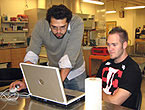Recent News
UNM Engineering team wins ASEE best paper for work on first-year engineering course
July 17, 2025
New director will enhance interdisciplinary engineering learning opportunities
July 2, 2025
Final SIRI cohort visits UNM campus
June 30, 2025
Perfetti receives ANS Landis Engineering Achievement Award
June 26, 2025
News Archives
Researchers Lead Program to Develop Blast Tolerant Composites
January 14, 2009
 Three University of New Mexico professors are spearheading an effort to develop blast resistant composite materials. The group is delving into ways to change the structure of materials – like concrete – into something that would be a good building material, more resistant to corrosion and specifically tolerant to blast.
Three University of New Mexico professors are spearheading an effort to develop blast resistant composite materials. The group is delving into ways to change the structure of materials – like concrete – into something that would be a good building material, more resistant to corrosion and specifically tolerant to blast.
“I don’t know what kind of material we will end up with. As you change its microstructure, is it concrete at all?” asked Mahmoud Taha, associate professor and Regents’ Lecturer in civil engineering. Joining Taha from UNM are assistant professors of mechanical engineering Marwan Al-Haik and Claudia Luhrs, distinguished national lab professor Jonathan Philips and graduate engineering students. Researchers from the University of Illinois at Urbana-Champaign and University of Texas as San Antonio are also involved.
Luhrs’ approach is to train and co-advise students on how to generate nanofiber in fiber microstructures. They are focusing on growing nanostructures that fit specific requirements – such as improving the flexibility of concrete structures, so that concrete cracks rather than crumbles when hit by a pressure wave from a blast.
“People in the last century used to design structures and use existing materials to build them, but we are going one step further, asking why do we need to use existing materials? Can we design our own?” Taha said. He envisions altering composite materials like glass fibers or metals like steel at the microstructure level into something that would be capable of resisting blasts – and lasting indefinitely – rather than deteriorating in 30 or 40 years.
The Army Research Office is providing $800,000. Other grants, $1.12 million from the Defense Threat Reduction Agency, and $230,000 from the National Science Foundation, will explore different areas of the core problem.
The research will be conducted in the School of Engineering’s new structural lab, and the mechanical engineering laboratories, where, Taha said, undergraduates are encouraged to participate in the project. So far five undergraduates are participating through a separate Undergraduate Research Experience Grant from the NSF.
